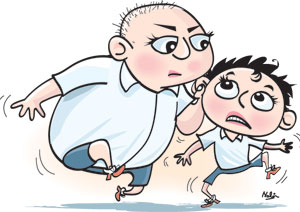A child suddenly refuses to go to school. He develops a tummy ache or a headache every morning of a school day.
Be alert, advises Prof. Hemamali Perera, Professor in Psychological Medicine, Faculty of Medicine, University of Colombo, to parents, for he may be facing the trauma of being bullied by one or a group in his own class, stressing that the mental health implications for such victims are huge.
She speaks with facts in her palm, for according to her 33% or 1/3rd of children who seek treatment for mental health issues at her clinic at the premier Lady Ridgeway Hospital for Children, Colombo, as well as for other physical illnesses have reluctantly admitted that they have been bullied in class.
The victims could range from those who are timid, passive, quietly sit at their work and those who lag behind in class to those who are picked on by the teacher for poor performance. When teachers come down hard on children without taking into consideration that they are little ones, the bully in the class will also zero in on them.
“The other end of the spectrum of victims could also be the studious, academically bright children who may be among the top-set in the class. If they are the teacher’s favourites, they could be at the butt end of bullying due to jealousy,” says Prof. Perera, while particularly focusing on children who may move to a new school, like the Grade 5 scholarship winners. They will be “dumped” in a new and unfamiliar school with a lot of expectations and be vulnerable to bullying.
On the other hand, the Sunday Times learns that an active or impulsive child could also be targeted by bullies in a different way -- exploiting his impetuosity and goading him to a dare such as knocking against a bigger boy which may result in him being punched or boxed.
Who are the little “thugs” in the class?
The thug or the bully will be the child who pushes, shoves, pinches or hits another regularly. He will not be able to resist the urge to indulge in name-calling or forcibly grabbing another child’s things.
He will also resort to threats and intimidatory acts including mouthing such statements as, “Mage Thaththa policeye” (My father is in the police). He is spiteful and insensitive.
Some parents may praise and glorify an aggressive child but regret later when the child turns on them, says Prof. Perera.
Stressing that the victims should be protected and the bullies curtailed and a close eye kept on them, she says that teachers should be aware that bullying does take place in the classroom and alert parents of both bullies and victims if they spot such behaviour.
While parents should suspect that something is wrong if a child is persistently shunning school with excuses such as headaches or tummy aches or falling back in his studies, teachers should avoid personal criticism of children, treating them with empathy, she says.
“Parents should also suspect bullying if a child who has been working well suddenly does not comply with classroom activity, is identified as quiet in class but becomes boisterous at home, doesn’t do his homework, throws unexpected tantrums and turns aggressive towards them and his siblings.”
Teachers, meanwhile, must suspect that something is amiss if a child leaves the classroom frequently complaining of headaches and tummy-aches, says Prof. Perera urging that all schools should have a clear no-bullying policy.
Schools should also have programmes to develop social skills of children who are timid, passive, inhibited or temperamentally shy to make them more socially-able, according to Prof. Perera.
Don’t dismiss (by condoning such acts as “boys will be boys”) or ignore bullying, she says, pointing out that if the authorities are keen to crackdown on ragging in universities, they should put a stop to bullying in the primary classroom. Prof. Perera’s logic is simple -- It’s the little thug who becomes the sadistic ragger
A loud “No” to bullying will permeate through the classrooms and up to university dissuading ragging in institutions of higher education.
Who’s a bully?
Bullying, according to many websites, is defined as intentional, repeated hurtful acts, words or behaviour such as name-calling, threatening and/or shunning of a child by one or more children. It can take place in the classroom, school, grounds, bus-stop or van transporting the children to and from school.
It can include unprovoked intentional inflicting or attempting to inflict, injury or discomfort upon another and comprise physical (hitting, kicking, pushing, choking), verbal (calling names, threatening, taunting, malicious teasing, spreading nasty rumours) or other actions (making faces or obscene gestures, or intentional exclusion from a group).
The general view is that while boys usually engage in direct bullying, girls use more subtle methods such as social isolation of their victim or spreading rumours about her. |


